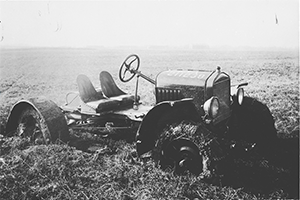100 Years of Excellence: The ATC Story, Part 2
Excerpted from an article by Lauren Nelson
Ford Reconnaissance Car stalled during a test, December 28, 1923.
When World War I concluded, Aberdeen Proving Ground took on a peacetime mission of research and development while the facilities and capabilities of the proving ground expanded at a steady pace. An airfield was completed in 1923 and named Phillips Army Airfield in honor of the pilot who died in an aircraft accident at the new airfield in June of that same year. Lt. Wendell K. Phillips died on June 5, 1923, when his Handley-Page bomber broke an axle and crashed on takeoff. Phillips was able to cut off the engine of the aircraft and avoid a fire, thereby saving all five of his passengers, though Phillips died from injuries soon after the accident.
The new Phillips Army Airfield witnessed a number of famous firsts with developments in aerial bombing. The world’s first 4,000-pound bomb was dropped by Sgt. Stewart C. Smink, a bombardier who would later command the Proving Ground Squadron of the Aberdeen Air Unit as Lieutenant Colonel. Phillips Army Airfield was also the first place where dive bombing tactics were tested. In addition, the first 75-mm aircraft cannon was fired from a B-18 aircraft piloted by Capt. C.S. Thorpe on October 12, 1939.
Ordnance testing of artillery and ammunition persisted, and it was during this interwar time period that the test mission of the Proof Department expanded to include automotive testing. Vehicles such as the Ford 6-ton tank, the Class B Liberty truck, and various predecessors of the World War II Jeep were tested at the Proving Ground. Construction began on an automotive test course in 1933, and vehicles were driven on its rough roads to test for endurance and speed. Examples of the successes of vehicular testing during this time were the experiments comparing Caterpillar treads to wheels in 1931. Caterpillar treads, also called continuous tracks, were a propulsion system using metal plates linked together in a band driven by two or more wheels. In tests conducted at the Proof Department, the Caterpillar tread was clearly superior in mechanized vehicle movement because the width of the tracks distributed the weight of the vehicle better than traditional tires. As a result, new combat vehicles sported the improved tread. From 1919 to 1940, new materials and items were brought to APG to be studied and proofed. Powders, projectiles, bombs, rapid fire weapons, interior and exterior ballistics, railway and seacoast artillery, tanks and tractors were tested and developed. Even though the United States was at peace, it was important to keep the military well supplied and ready to face any new conflict.
Problems periodically arose when a test had an unforeseen effect on APG’s environment. For example, in 1923, bombs containing phosphorous nitrate were tested by being dropped in areas of the Upper Chesapeake Bay. Two years later in 1925, hundreds of dead waterfowl were found in the water and on shore by local sportsmen.
The Maryland Conservation Commission launched an investigation, concluding that the chemicals from the bombs dropped in 1923 were the cause. The Army detailed Soldiers to patrol the shores in boats, shooing away any ducks that attempted to land, as well as depositing mud and silt over the contaminated areas.
Incidents such as these made APG more aware of the effects that proof testing and the construction of facilities had on the surrounding community and environment. To combat negative effects, the Civilian Conservation Corps was utilized in July 1935. Several hundred men were employed to take on a number of projects to benefit the Proving Ground, as well as the environment. The Corps took on shore erosion work; drainage work at test courses; construction of firebreaks; clearing of brush, poisonous weeds and shrubs; planting of trees; and ditching of marshland. APG’s extensive acreage became an informal reservation. Hunting was limited in the hopes that the area would become a game preserve. These projects initiated the transformation of the Proving Ground from the flat, treeless farmland which the Army had first purchased, to the richly wooded expanse that endures today.
You are now leaving www.atc.army.mil and entering another site. You will automatically be forwarded to the target page within five seconds.

